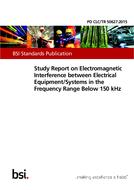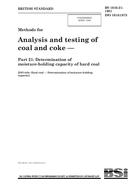
BS PD CLC/TR 50627:2015
Click here to purchase
BS PD CLC/TR 50627:2015 is based on two Study Reports of CLC/SC 205A, having been worked out by their TaskForce EMI [1a][1b] and provides the results and findings of these documents. It was created with the help andinput from a broad range of involved stakeholders: network operators, equipment manufacturers, universities,accredited test houses and consultants.
Beside the actual standardization situation it reflects the current emission situation found in supply networksand installations and describes electromagnetic interference (EMI) cases from twelve countries; investigationand analysis of the latter show a wide range of different types of electrical devices to be considered as asource or a victim of related EMI.
This Technical Report highlights the occurrence of high levels of non-intentional emissions (NIE) in theconsidered frequency range, including values up to and exceeding the standardized limits for intentionalsignals from mains communicating systems (MCS), which also implies a high potential to cause EMI to otherelectrical equipment. On the other hand, several types of equipment show susceptibility to related emissions,being insufficiently immune.
The Technical Report addresses the following issues:
- a number of different types of electrical equipment are generating such emissions and/or are susceptible,to such, thus representing EMI potential, as a source or a victim of such EMI;
- the interaction of electrical equipment in a certain supply area respectively installation, with its complexand volatile impedance character, as having an additional EMI potential; that besides NIE from generalelectrical equipment and signals from MCS and technically being quite different from emissions;
- the fact that besides the conducted interference also radiated interference from NIE or signals from MCS,through the magnetic H-field following to related currents on the mains, is to be considered, what is ofsome importance also for the interference-free operation of broadcast time-signal systems or electroniccircuits controlled by such;
- the ageing of electronic components in electric equipment, which causes increased emissions and EMI toother electrical equipment as a result of not showing the same EMC characteristics as before beingplaced on the market, therefore no longer being able to conform with EMC requirements;
- the additional aspect of differential mode operation, which should be considered for related immunity andtesting specifications.
These findings confirm that EMI in this frequency range is not limited to single types of equipment likeinverters or MCS; instead a more general electromagnetic compatibility (EMC) problem concerning a largerspectrum of electrical equipment is identified.
Although a case-by-case mitigation of related EMI cases might be seen as appropriate, the increasingapplication of technologies and systems with related EMI potential requires a more general solution, throughstandardization, taking a balanced viewpoint of EMC and economics into account. With regard to the actualstandardization situation, a review of the actual EMC and Product standards based on the reported resultsseems to be advisable.
After initiating the work in CLC/SC 205A, the now ongoing work in IEC SC 77A, as well as the publication of arelated Technical Report on testing electricity meters [2] by CLC/TC 13 and of the new Immunity testingstandard EN 61000-4-19 [99], appear as right steps into the right direction but needing further, extendedefforts.
As stated on European as well as on international EMC standardization level, the availability of compatibilitylevels for the considered frequency range appears as a key-requirement for future considerations on settingrelated emission limits and immunity requirements in various standards. A fundamental basis for the coexistence of intentional signals from MCS and NIE needs to be found.
Cross References:
CLC/TR 50579:2012
2010/31/EU
Regulation (EU) No 244/2012
2014/30/EU
EN 50065-1:2011
EN 61000-3-2:2006
EN 61000-3-2:2006+A1:2009
EN 61000-3-2:2006+A2:2009
EN 61000-3-3:2013
EN 61000-2-2:2002
EN 55011:2009+A1:2010
EN 55015:2006+A1:2007
EN 55015:2006+A2:2009
EN 61000-4-16:1998+A1:2004
EN 61000-4-16:1998+A2:2011
EN 50065-2-1:2003+A1:2005
EN 50065-2-2:2003
EN 50065-2-2:2003+A1:2005
EN 50065-2-3:2003+A1:2005
IEC 61000-3-8:1997
IEC 61334-3-1:1998
EN 50065-4-1:2001
EN 50065-4-2:2001+A1:2003
EN 50065-4-2:2001+A2:2005
EN 50065-4-3:2003
EN 50065-4-4:2003
EN 50065-4-5:2003
EN 50065-4-6:2004
EN 50065-4-7:2005
EN 50065-7:2001
IEC/TS 62578:2014
EN 55022:2010
CISPR 22:2008
EN 55032:2012
CISPR 32:2012
EN 50470-1:2006
EN 50470-3:2006
IEC/TR 61000-2-5:2011
IEC/TR 61000-2-1:1995
IEC TS 50572:2009
IEC 61800-3:2004:2012
EN 61000-2-12:2003
IEC 61000-2-12:2003
EN 50160:2010
EN 61547:2009
EN 61000-4-19:2014
IEC 61000-4-19:2014
EN 61000-4-6:2014
CLC/TR 50422:2013
2009/72/EC
96/92/EC
2003/54/EC
2006/32/EC
2005/89/EC
2012/27/EU
2009/125/EU
IEC/TR 61000-2-3:1992
All current amendments available at time of purchase are included with the purchase of this document.
Product Details
- Published:
- 12/31/2015
- ISBN(s):
- 9780580853326
- Number of Pages:
- 88
- File Size:
- 1 file , 6.8 MB
- Product Code(s):
- 30295002, 30295002, 30295002
- Note:
- This product is unavailable in United Kingdom

